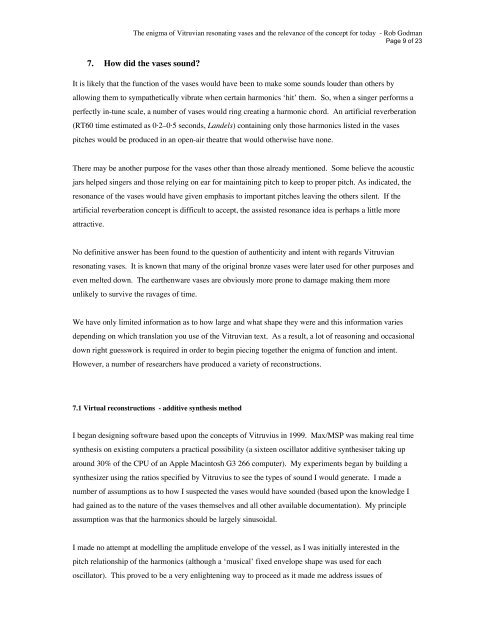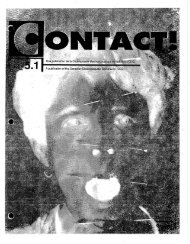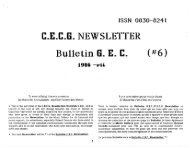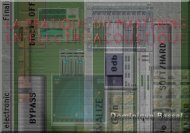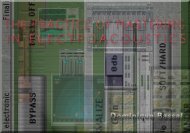The enigma of Vitruvian resonating vases and the relevance ... - CEC
The enigma of Vitruvian resonating vases and the relevance ... - CEC
The enigma of Vitruvian resonating vases and the relevance ... - CEC
Create successful ePaper yourself
Turn your PDF publications into a flip-book with our unique Google optimized e-Paper software.
<strong>The</strong> <strong>enigma</strong> <strong>of</strong> <strong>Vitruvian</strong> <strong>resonating</strong> <strong>vases</strong> <strong>and</strong> <strong>the</strong> <strong>relevance</strong> <strong>of</strong> <strong>the</strong> concept for today - Rob Godman<br />
Page 9 <strong>of</strong> 23<br />
7. How did <strong>the</strong> <strong>vases</strong> sound?<br />
It is likely that <strong>the</strong> function <strong>of</strong> <strong>the</strong> <strong>vases</strong> would have been to make some sounds louder than o<strong>the</strong>rs by<br />
allowing <strong>the</strong>m to sympa<strong>the</strong>tically vibrate when certain harmonics ‘hit’ <strong>the</strong>m. So, when a singer performs a<br />
perfectly in-tune scale, a number <strong>of</strong> <strong>vases</strong> would ring creating a harmonic chord. An artificial reverberation<br />
(RT60 time estimated as 0·2–0·5 seconds, L<strong>and</strong>els) containing only those harmonics listed in <strong>the</strong> <strong>vases</strong><br />
pitches would be produced in an open-air <strong>the</strong>atre that would o<strong>the</strong>rwise have none.<br />
<strong>The</strong>re may be ano<strong>the</strong>r purpose for <strong>the</strong> <strong>vases</strong> o<strong>the</strong>r than those already mentioned. Some believe <strong>the</strong> acoustic<br />
jars helped singers <strong>and</strong> those relying on ear for maintaining pitch to keep to proper pitch. As indicated, <strong>the</strong><br />
resonance <strong>of</strong> <strong>the</strong> <strong>vases</strong> would have given emphasis to important pitches leaving <strong>the</strong> o<strong>the</strong>rs silent. If <strong>the</strong><br />
artificial reverberation concept is difficult to accept, <strong>the</strong> assisted resonance idea is perhaps a little more<br />
attractive.<br />
No definitive answer has been found to <strong>the</strong> question <strong>of</strong> au<strong>the</strong>nticity <strong>and</strong> intent with regards <strong>Vitruvian</strong><br />
<strong>resonating</strong> <strong>vases</strong>. It is known that many <strong>of</strong> <strong>the</strong> original bronze <strong>vases</strong> were later used for o<strong>the</strong>r purposes <strong>and</strong><br />
even melted down. <strong>The</strong> ear<strong>the</strong>nware <strong>vases</strong> are obviously more prone to damage making <strong>the</strong>m more<br />
unlikely to survive <strong>the</strong> ravages <strong>of</strong> time.<br />
We have only limited information as to how large <strong>and</strong> what shape <strong>the</strong>y were <strong>and</strong> this information varies<br />
depending on which translation you use <strong>of</strong> <strong>the</strong> <strong>Vitruvian</strong> text. As a result, a lot <strong>of</strong> reasoning <strong>and</strong> occasional<br />
down right guesswork is required in order to begin piecing toge<strong>the</strong>r <strong>the</strong> <strong>enigma</strong> <strong>of</strong> function <strong>and</strong> intent.<br />
However, a number <strong>of</strong> researchers have produced a variety <strong>of</strong> reconstructions.<br />
7.1 Virtual reconstructions - additive syn<strong>the</strong>sis method<br />
I began designing s<strong>of</strong>tware based upon <strong>the</strong> concepts <strong>of</strong> Vitruvius in 1999. Max/MSP was making real time<br />
syn<strong>the</strong>sis on existing computers a practical possibility (a sixteen oscillator additive syn<strong>the</strong>siser taking up<br />
around 30% <strong>of</strong> <strong>the</strong> CPU <strong>of</strong> an Apple Macintosh G3 266 computer). My experiments began by building a<br />
syn<strong>the</strong>sizer using <strong>the</strong> ratios specified by Vitruvius to see <strong>the</strong> types <strong>of</strong> sound I would generate. I made a<br />
number <strong>of</strong> assumptions as to how I suspected <strong>the</strong> <strong>vases</strong> would have sounded (based upon <strong>the</strong> knowledge I<br />
had gained as to <strong>the</strong> nature <strong>of</strong> <strong>the</strong> <strong>vases</strong> <strong>the</strong>mselves <strong>and</strong> all o<strong>the</strong>r available documentation). My principle<br />
assumption was that <strong>the</strong> harmonics should be largely sinusoidal.<br />
I made no attempt at modelling <strong>the</strong> amplitude envelope <strong>of</strong> <strong>the</strong> vessel, as I was initially interested in <strong>the</strong><br />
pitch relationship <strong>of</strong> <strong>the</strong> harmonics (although a ‘musical’ fixed envelope shape was used for each<br />
oscillator). This proved to be a very enlightening way to proceed as it made me address issues <strong>of</strong>


